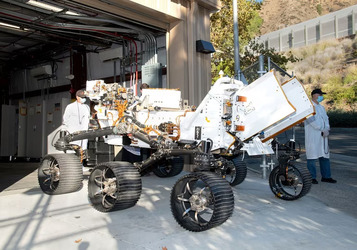The week's pick
Random Articles
Reseach Article
Study and Analysis of GNSS Signals using In-house Developed Interference Tool
| Communications on Applied Electronics |
| Foundation of Computer Science (FCS), NY, USA |
| Volume 4 - Number 2 |
| Year of Publication: 2016 |
| Authors: Deepak Mishra, Ram Prabu Ganesan, Alak Banik |
 10.5120/cae2016652050
10.5120/cae2016652050
|
Deepak Mishra, Ram Prabu Ganesan, Alak Banik . Study and Analysis of GNSS Signals using In-house Developed Interference Tool. Communications on Applied Electronics. 4, 2 ( January 2016), 32-38. DOI=10.5120/cae2016652050
Abstract
Interference analysis of navigation signals belonging to the same group and with the signals of the satellites belonging to other groups is an important parameter that must be considered while designing a GNSS receiver and for introducing a new signal for any GNSS satellite. Troposphere and ionosphere are the layers of the atmosphere which affect the GNSS signals by creating delays and scintillations. Multipath is one of the major cause which creates maximum error budget at the receiver side of the GNSS system. The error budget differs with the type of correlator that is used. The number of navigations satellites and the services provided by them are increasing fast increasing the interference with other signals. So for this reason analysis of the interference of the signal using C/N0 degradation measurement [ITU recommendation M.1831] and the effect of troposphere, ionosphere and multipath on various signals is necessary. In this paper, an attempt has been made to develop a tool for interference analysis of the various GNSS signals, using this tool this paper analyses the degradation of the IRNSS signals due to troposphere, ionosphere and multipath effects of the GNSS signals.
References
- Hoffmann-Wellenhof, Lichtennegger, Wasle, “GNSS Global Navigation Satellite Systems GPS, GLONASS, Galileo & more”, SpringerWeinNewYork.
- Simon Haykin, “Digital Communications”, John Wiley & Sons (Asia) Pte Ltd.
- John W. Betz, “Binary Offset Carrier Modulations for Radio navigation”, The MITRE Corporation, Bedford, Massachusetts Received September 2001; Revised March 2002.
- Gunter W Hein, Markus Irsinger, Jose Angel Avila radriguez and Thomas Pany, “Performance analysis of L1 Galelio Signals”, Institute of Geodesy and Navigation, University FAF Munich, Germany.
- Wei Liu, Yuan Hu, Xingqun Zhan, and Chuanrun Zhai, “Assessing Radio Frequency Compatibility between Galileo and Compass”, Defence Science Journal, Vol. 61, No. 6, November 2011, pp. 545-553, DOI: 10.14429/dsj.61.285.
- José Ángel Ávila Rodríguez ,” Doctoral Thesis On Generalized Signal Waveforms for Satellite Navigation”, Munich, June 2008.
- Hopfield HS (1969), “Two quadratic tropospheric refractivity profile for correcting satellite data”, Journal of Geophysical Research, 74(18):4487-4499.
- Saastamoinen J (1973), “Contribution to the theory of atmospheric refraction”, Bulletin Geo-desique, 107:13-34.
- Klobuchar J (1986), “Design and characteristics of the GPS ionospheric time delay algorithm for single frequency users”, Proceedings of PLANS’86-position location and navigation Symposium, Las Vegas, Nevada.
- “A coordination methodology for RNSS inter-system interference estimation”, ITU, 2007
- Oppenheim AV, Schafer RW, Buck JR (1999), “Discrete –time signal processing”, second edition, Prentice Hall, London.
- www.navipedia.com
- Stefan Wallner, Guenter W Hein and Jose- Angel Avila – Rodriguz, “Interference computation between several GNSS systems”, Institute of Geodesy and Navigation, University FAF Munich, Germany.
- S.Wallner and G.W.Hein, “Interference computation between GPS and Galileo”, ION,pp.1-15
- M MainulHoque and Novbert Jakowki, “Ionospheric Propagation Effects on GNSS signals and new correction approaches”, German Aerospace Center, Neustrelity, Germany.
- Y Benigal, “Global ionospheric Scintillation model”
- Rene Warnat, “Atmospheric Perturbations on GNSS signals and their influence on time transfer”, Royal observatory of Belgium, Brussels
- A,Hornbostel, “Propagation problems in satellite navigation”, DLR, Institute of Communication
- Elliot D. Kaplan, Christopher J. Hegarty, Artech House, “ Understanding GPS Principles and Applications”, Artech House Publications
- GPS Navigation Toolbox GNT08.1.2
- Brandford W Parkison, James J Spilker, “Global Positioning System Theory and applications”, AIAA series, Vol.164
- Eingereicht von, “On ground based GPS Tropospheric Delay and Estimation”, Disserbation weirde der Universitat der Bundesuwehr Michen
- Dr NBS Srilatha Indira Dutt, Shaik Gowsuddin, “ionosphere Delay Estimation using Klobuchar Algorithm for single frequency GPS receiver”, IJARCE, Vol2, Issue2 feb2013
- www.ieea.fr available at: IEEA : Antennas, Propagation, EMC, RCS etc.
Index Terms
Keywords

